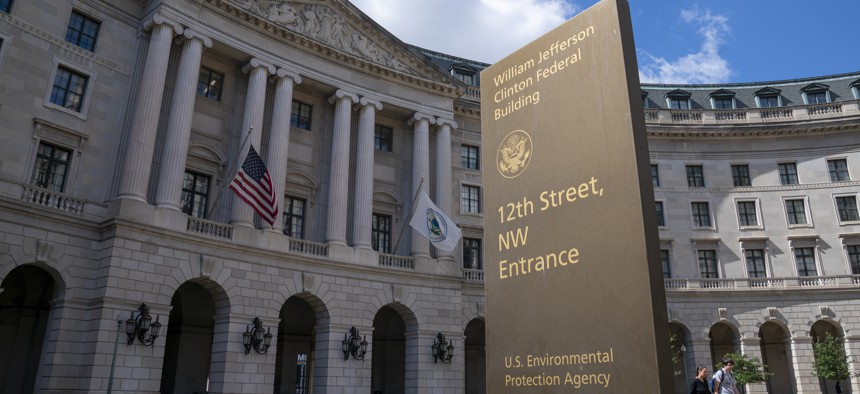California Fires Back Over Trump Administration’s Water, Air Complaints

The headquarters of the Environmental Protection Agency is seen in Washington. AP Photo/J. Scott Applewhite
State agencies said many of the water and air quality violations flagged by the EPA in a series of letters issued in September were already being addressed or were based on incorrect data.
California officials this month pushed back against the Environmental Protection Agency’s accusations that the state is not doing enough to address water and air quality violations, while also accusing the federal government of neglecting its own environmental responsibilities.
In two letters detailing plans of action to address the EPA’s concerns, state officials disputed some violations and outlined steps already being taken to address issues identified by the Trump administration.
The EPA sent a series of letters to California last month detailing alleged violations of federal environmental laws, actions local leaders and environmental experts believe amounted to political retaliation against the Democrat-led state. In a letter sent Sept. 24, the EPA threatened to cut California’s federal highway funding unless it resubmitted plans outlining strategies to deal with air pollution. Days later, EPA Director Andrew Wheeler followed up with a second letter that said California was “failing to meet its obligations” to enforce water quality standards, along with tying the violations to the state’s homelessness crisis.
The California Environmental Protection Agency (CEPA) responded to the water quality allegations Friday, writing that the federal government “is not fulfilling its responsibilities in California,” for example by not taking action to address sewage discharges from a federal facility operated in the Tijuana River Valley or a sewage discharges coming from Mexico and contaminating the New River.
As far as the state’s alleged violations, the CEPA wrote that the state’s water resources control board had already reduced by more than half the number of water facilities that were not in compliance with the Clean Water Act. Further, the state agency said that three of the violation examples highlighted in the EPA’s letter were actually not violations at all. In one instance, the state said the level of cyanide reported as being more than 5,000% above the allowable limit in one water district was a mistake based on incorrect data. And a carcinogen found in excessive levels in Los Angeles’ water was tied to the occurrence of wildfires.
“U.S. EPA’s own data show California is ahead of other states and U.S. EPA in terms of compliance and enforcement,” wrote Jared Blumenfeld, CEPA’s secretary.
The state agency called Wheeler’s insinuation that “piles of human feces” from homeless people were contaminating major city streets and sewer systems “sensationalized” and “misguided.” But the agency said local water boards are already starting to require municipalities to assess the level of contamination and reduce such pollution.
Many of the Safe Water Drinking Act violations cited in the EPA letter have already been brought back into compliance and were episodic in nature, Blumenfeld wrote. The state said it was already working to address concerns regarding San Francisco’s combined stormwater and sewage system and the potential for untreated water to flow into the Pacific Ocean and the San Francisco Bay. The San Francisco Bay Water Board adopted more stringent permitting for ocean discharges just days before the EPA sent the letter, a plan that the EPA had originally pursued in conjunction with the board, Blumenfeld wrote.
“U.S. EPA recently abandoned the joint enforcement effort with California and has instead chosen to proceed unilaterally,” he wrote. “This development is confounding, and contrary to long history of productive state-federal cooperative enforcement.”
An EPA spokesperson said the agency is reviewing the responses submitted by California to the two oversight letters.
“Because California has the worst air quality in the nation along with other serious environmental challenges, we stand ready to assist the state in addressing these very serious concerns to ensure the protection of public health and the environment for all Californians,” the spokesperson said.
The EPA’s focus on California comes despite the fact that Safe Drinking Water Act violations, including health-based violations, are pervasive across the country. A Natural Resources Defense Council report in 2017 found that there were 12,000 health-based violations in about 5,000 community water systems in 2015.
The EPA had also warned California that 127 of its state implementation plans (SIP), which are drafted by local officials to guide the region’s approach to improving air quality when it does not meet federal standards, were out of date and risked disapproval if they were not updated.
In a letter submitted to EPA on Oct. 9, the California Air Resources Board blamed the backlog of SIP approvals on EPA, saying they are “the result of staff shortages, competing administrative priorities, and a lack of clear guidelines emanating from headquarters bureaucracy.” CARB’s Chairwoman Mary Nichols wrote that the state’s review found that the state had submitted all information sought by EPA for two-thirds of the SIPs and the state was only awaiting action by the EPA.
In the time since Wheeler issued the letters targeting California for compliance, the New York Times reported that water pollution letter was drafted without consultation with California-based EPA officials, who after the fact believed the allegations were exaggerated.
Nearly 600 former EPA employees also wrote to two U.S. House of Representatives committees to request an investigation into whether the agency’s crackdown on California for water and air pollution violations was politically motivated. They wrote that six other states—Ohio, New York, Iowa, Missouri, Texas and Indiana—are bigger violators of federal environmental laws than California.
Editor's note: This story was updated after publication to include the EPA's statement.
Andrea Noble is a staff correspondent for Route Fifty.
NEXT STORY: Hospitals Take Shot At Opioid Makers Over Cost Of Treating Uninsured For Addiction





